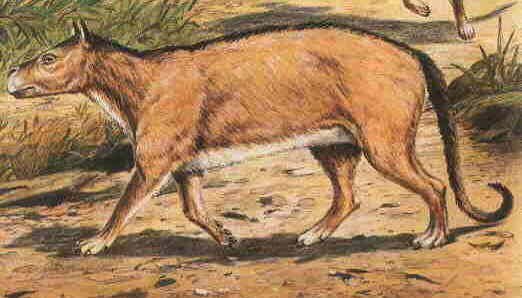More doglike, but ok.
Later fossils are of bigger animals. This, then proves evolution. Not really. It is like saying that a clydesdale evolved from a shetland pnoy, just because one is larger than the other.
Oh, puh-LEAZE...
You've been reading too many creationist sources too, haven't you? It's practically an epidemic.
Just once, I'd love to be pleasantly surprised by an anti-evolutionist who actually went and READ SOME PRIMARY SCIENTIFIC LITERATURE, *then* came back with criticisms or questions. But no, they all show no sign of having just read 9 parts creationist misrepresentations and 1 part popularized newspaper accounts of scientific studies (and we all know how accurate the media is, don't we?), then think they've seen the best that science can do.
Sigh.
No, Plusone, the horse lineage is *not* simply based on "oh look, it's bigger therefore it must have evolved from a smaller one". If that straw-man, ridiculously simplistic misrepresentation were all that scientists did, then yeah, you'd have good cause to scorn them.
But it's not what they do, that's only what *creationists* falsely claim that they do.
First, you're giving the misleading impression that horse evolution is only traceable through size variations. This is quite simply untrue. And you also try to have it both ways, by first mentioning that the proto-horse was "catlike", then immediately talking only about mere size differences among modern horses (clydesdale and shetland pony).
The modern horse is traceable back to a the earliest mammals (and back beyond that to reptiles, then amphibians, then fish, etc.)
And the "proto horse" is so different from a modern horse of *any* size that it's not simply a matter of size variation within "horselike" animals. Here's a full body reconstruction from the skeleton of an early horse ancestor:

Not very horselike at all, is it?
Going back further, the horse lineage includes early insectivorous mammals like:

The evolution of the horse is verifiable through *far* better evidence than your simplistic "it came later and it's bigger" straw man (and in fact, evolution hardly expects animals to necessarily grow in size -- certain branches of the horse family *shrunk* in size over time)
The evolution of the horse is traceable by the timewise rise of a series of new species, each of which existed nowhere prior in the fossil record, differing from species which came immediately before them in small, stepwise ways while retaining dozens of characteristic features that plainly mark them as being otherwise very closely related, within the same geographical area as their predecessors. That's a hell of a lot more foolproof than your description of "it's later, it's bigger, good enough".
It produces a branching tree that looks like this:

And that's not even mentioning the mountains of DNA evidence which clearly links the diverse living members of the horse family (horses, zebras, asses) to each other, and the other ungulates, from original common ancestors.